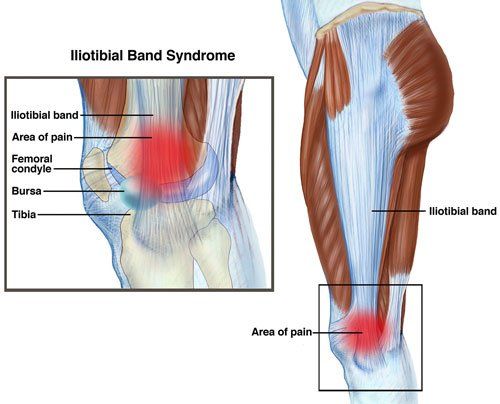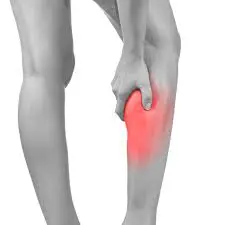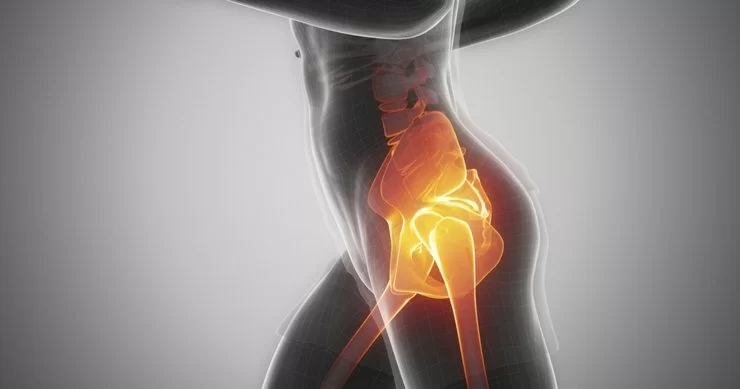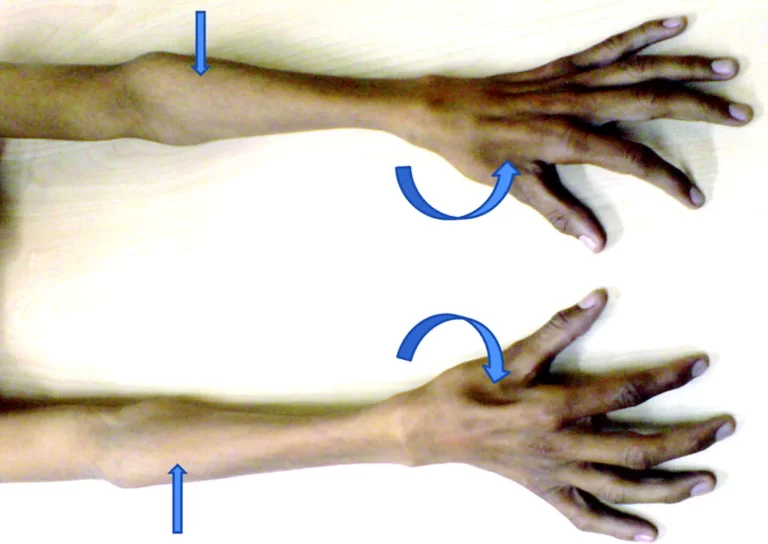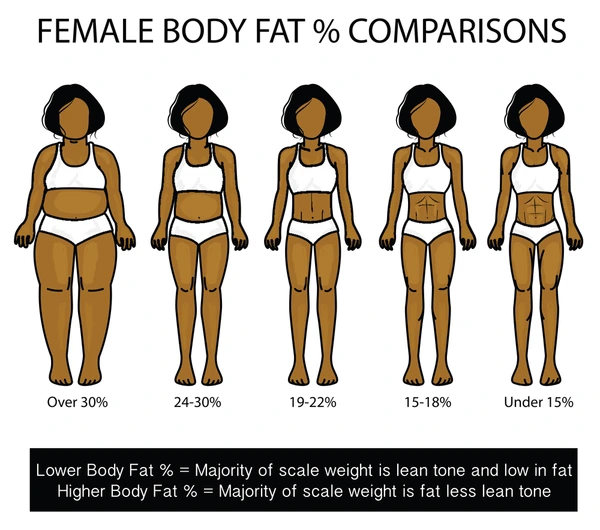27 Best Pulling Exercises For Upper Body
Introduction:
When it comes to developing a strong and well-defined upper body, incorporating effective pulling exercises into your workout routine is essential. Pulling exercises target the muscles of the back, shoulders, and arms, helping to improve overall upper body strength, stability, and aesthetics.
In this guide, we will explore some of the best pulling exercises that engage various muscle groups, providing a comprehensive approach to building a balanced and powerful upper body. Whether you’re a beginner or an experienced fitness enthusiast, incorporating these pulling exercises can contribute to a well-rounded and functional physique.
A resistance exercise involving horizontal or vertical force applied to the back muscles is sometimes called an upper-body pulling exercise. The main purpose of these exercises is to strengthen the pull muscles that are already a part of your training routine. A pull strength training regimen is a type of strength training where your workouts are divided into distinct muscle groups. Pulling is essential to functional daily movement, whether lifting groceries or paddling on a canoe.
Pulling exercises are simply a very simple, non-scientific method of categorizing certain movements. The fact that muscles pull across joints to control limbs means that all movements are actually “pulling” movements. Pull-ups, chin-ups, bent-over rows, shrugs, bicep curls, face pulls, and inverted rows are a few good examples of body pull exercises. Pulling activities to strengthen the forearms, biceps, and back. This may enhance muscular strength. One of the finest ways to tone your entire body and improve at the workouts you love is to strengthen those pull muscles.
Bodybuilders and other athletes love these workouts because they maximize recovery time in between sets and aid in developing a balanced body. Depending on your training objectives and personal preferences, you can alter the number of repetitions, sets, and focus muscles worked during a given session. Several of the main muscles in your upper body can be strengthened and their sizes increased with a pull-day workout.
In upper-body pull exercises, the following muscles are used:
- The latissimus dorsi
- Both major and minor rhomboids
- Trapezius, or the traps
- Teres major, a little muscle located next to the shoulder blade
- Brachii Biceps
Advantages:
A program of upper-body pull training has many advantages.
- Enhancing alignment in all situations.
- Gaining strength in your arms is essential for cycling, running, and swimming.
- lowering the chance of injury, which goes up when you exercise with bad posture.
- Enhancing your core and arm strength.
- Assisting your body’s increased rate of calorie burning.
- Exercises involving pulling are good for building back muscles.
- Pull exercises can increase the power and range of motion in your muscles.
The ideal exercise to strengthen your upper body is:
There are several exercises you can perform frequently to improve your best strength-training activity;
The bend-over row of barbells
- Place your feet shoulder-width apart and take a stand behind a barbell.
- Maintaining a straight back and slightly bent knees, bend at the hips.
- When positioning yourself to lift the barbell, try thinking about sitting back a little bit and shifting your tailbone behind your feet.
- You should be able to bend your body forward to a 45-degree angle, but no more.
- With your hands towards your shins and your forearms pronated, grasp the bar slightly wider than shoulder width.
- Bring the bar to your abs by pulling your elbows up behind you while contracting your glutes and core.
- Maintaining a straight back, continue to draw your elbows behind you and push your shoulder blades together.
- Hold on for a single second.
- Then, with your arms extended and the barbell plates slightly off the ground, slowly drop the bar back to the beginning position.
- Then relax.
- Do five to ten repetitions of this workout each day.
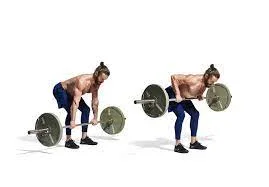
Dumbbell shrugs
- To begin, place your feet hip-width apart and bend your knees just a little bit.
- With your curled fingers towards the sides of your thighs, hold a dumbbell in each hand.
- Raise your shoulders to your earlobes while maintaining a straight arm position.
- Once you’ve completed the required number of repetitions, drop your shoulders.
- For optimal contraction, raise your shoulders near your ears and compress your trapezius.
- Then relax.
- Do five to ten repetitions of this workout each day.
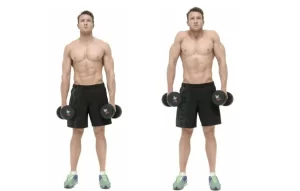
Biceps curls
- As you stand, spread your feet hip-width apart.
- Holding two dumbbells at your sides with your palms facing forward, take hold of them.
- Keeping your elbows fixed at your sides, curl the dumbbell up towards your shoulders.
- Once again, turn the dumbbell so that your hands are facing forward.
- Lock out your elbows and press the weights straight up from this position.
- Gradually reverse the action to return to your shoulders and eventually your waist.
- Return to your neutral stance.
- Then relax.
- Then repeat with the other hand.
- Do five to ten repetitions of this workout each day.
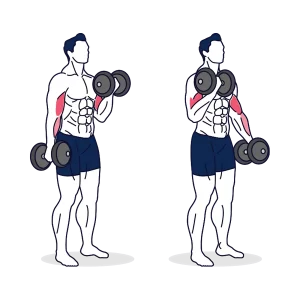
Seated Cable Row
- Place yourself at the low pulley station and give the handle a thumbs-up.
- Maintaining a neutral spine, push your legs into the support platform.
- Your knees should be slightly bent when you begin, and your chest should be pumped up to help activate your upper back. (muscles that provide stability).
- Without rounding your back, pull forcefully with your elbows as though your hands were just meaty hooks.
- During the peak contraction, the handle should almost touch your abdomen, and your elbows should be positioned slightly behind your torso.
- Reduce the weight gradually and allow your back to extend as much as it can, extending your shoulder blades forward.
- One approach to work the lats, trapezius, and rhomboids is with this intense stretch.
- Take care not to round your lower back when lifting and lowering the weight, and avoid swinging the weight of your upper body with momentum.
- Then relax.
- Do five to ten repetitions of this workout each day.
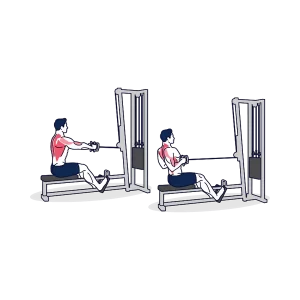
Meadows Row
- Place yourself on one side of a landmine station, legs slightly bent, in a staggered stance.
- Use your front leg to provide support for the arm on the same side.
- Maintain a straight spine and a bowed waist.
- Grab the barbell sleeve with a pronated (palm-down) grip using the lifting straps.
- The thick and smooth sleeve means that grip strength won’t be a limiting issue while using the lifting straps.
- Use your elbow to drive it home firmly to lift the weight.
- Instead of keeping your elbow pressed to your ribs, let it flare out to draw attention to your upper back.
- Maintain a flat, not rotated, torso.
- Use smaller 25-pound or 10-pound plates rather than 45-pound plates to maximize the range of motion.
- Then relax.
- Do five to ten repetitions of this workout each day.
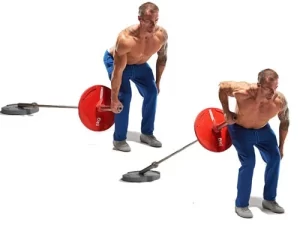
Inverted Row
- Place a sturdy bar, such as a Smith machine, at waist height.
- Because you’ll be lifting more body weight, the workout will be harder if you lower the bar.
- With a grip that is marginally wider than shoulder width, either pronated (palm down) or supinated (palm up), lie beneath the bar and grasp it. ( upward).
- Pull yourself up until your chest meets the bar by squeezing your shoulder blades together.
- With poise, bow down.
- Maintain as much elasticity in your body as you can to maximize the effects.
- For every rep, keep your body straight and contract your abdominal and glutes.
- While you extend at the bottom, keep your scapulas in place.
- Stay focused and let’s strengthen our core stability.
- Then relax.
- Do five to ten repetitions of this workout each day.
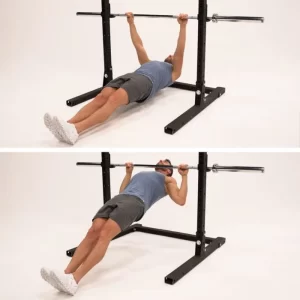
Chest-Supported Row
- The incline bench should be calibrated to an around 45-degree point.
- With your head above and your chest at the top, lie against the bench.
- With your feet in a secure stance, brace your core.
- Except for your arms and shoulder blades, you won’t move during the raise.
- Using a pair of dumbbells or kettlebells, begin rowing while bringing your elbows up to a high position.
- As you can, squeeze as hard and high as you can. Then, gradually release the weight to extend fully.
- Use a neutral grip, with your palms facing each other, and keep your elbows close to your body to accentuate your lats.
- Put your elbows to the sides and adopt a pronated hold (palms down) for more engagement of the upper back.
- Then relax.
- Do five to ten repetitions of this workout each day.
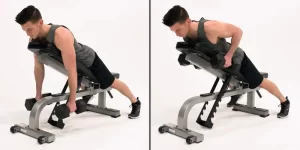
Face Pull
- Attach a rope to a pulley that is situated at chest height.
- Thumbs facing you and pinkies facing away, grasp the rope.
- Step back until the weight plates are slightly elevated, then extend your arms while maintaining a slight bend in your elbows.
- Puff out your chest, flatten your back, and bend your knees for stability.
- Raise the weights to the level of your forehead.
- The term comes from placing each hand on the side of your face.
- After a few moments of holding the contracted position, gradually return the weight to its starting position.
- Packing your shoulder blades together and pulling with your elbows is a better way to flex your arms than utilizing your biceps.
- Then relax.
- Do five to ten repetitions of this workout each day.
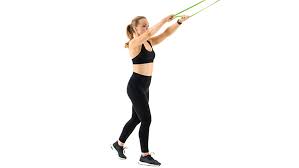
Banded Dumbbell Pullover
- Place your feet firmly on the floor, your upper body completely supported, and your head at one end of a flat bench.
- Avoid performing the exercise by lying sideways across the bench, as some lifters do.
- Dumbbells should be placed on the floor behind your head.
- Use a resistance band with one end attached to the dumbbell and the other to secure it to a sturdy rack, or an incredibly heavy dumbbell, or have a partner hold it in place.
- With your palms resting on the underside of the weights encircling the handle, grasp the dumbbell.
- Holding the dumbbell above your head, bend your arms slightly.
- As you drop the weight behind your head into a deep stretch, keep your glutes on the bench.
- Against the band tension, pull it back to the beginning position.
- Then relax.
- Do five to ten repetitions of this workout each day.
- Elbow flexion should not be done consciously since this will force the triceps to bear more of the strain instead of the back.

Banded Pull-Up
- Stretch a resistance band so you can walk into it after securing it on a rack.
- You should be able to perform 8 to 10 repetitions with the band resistance before your muscles start to tire.
- With your hands slightly broader than your shoulders, hold the bar palm down.
- As you begin to raise yourself up, maintain your elbows in front of your torso.
- Maintaining an arched chest is essential; failing to do so by moving your shoulders forward could cause injuries by shifting the stress of the exercise from the back muscles to the shoulder joints.
- Consider leading by reaching up to the ceiling with your chest.
- For a maximal stretch, lower yourself to a dead-stop hang.
- Then relax.
- Do five to ten repetitions of this workout each day.
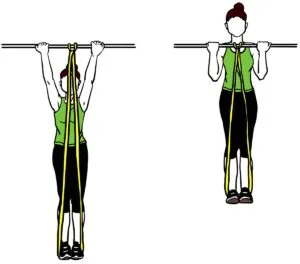
T-Bar Row
- A barbell can be fastened to a landmine attachment or fixed into a gym corner.
- Attach a double-D handle to the barbell’s base at the shaft’s base.
- Place your feet hip-width apart in front of the barbell’s base to begin.
- When you grab the handlebar, pretend that you are shutting your armpits to increase stress.
- With your elbows completely extended and your hips back, stand up while holding the weight in your hands.
- Make sure your torso is parallel to the floor and your spine is neutral for the starting posture.
- Sweep the elbows back, aiming for your lower chest.
- Return to the starting position by carefully extending the elbows to complete the repeat.
- Then relax.
- Do five to ten repetitions of this workout each day.
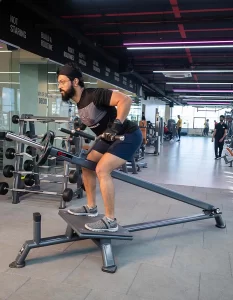
Single Arm Dumbbell Row
- Hang a dumbbell on the side of the bench that is farther away from you while you take a position off to one side of the bench.
- Position one foot off to the side, one knee firmly positioned within the bench, and one open hand at the head of the bench.
- Drive the elbow on the side holding the dumbbell back until it reaches a 90-degree angle, starting from the elbow that is fully extended angles and in line with the back of your torso.
- To finish the repetition, bring the rowing arm back to its maximum extension.
- Then relax.
- Do five to ten repetitions of this workout each day.
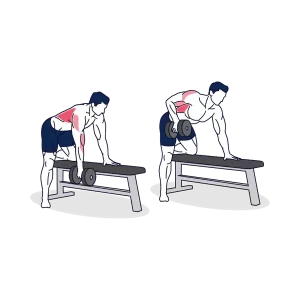
Single-Arm Cable Row
- Align the cable stack with your lower chest and upper abdomen.
- Hold the handle firmly in your palm.
- Move with both of your feet the hip width aside.
- Pose with your spine neutral and your chest open.
- Pull the handle in the direction of your upper abdomen/lower chest.
- To finish the repetition, extend the elbow straight.
- Then relax.
- Do five to ten repetitions of this workout each day.
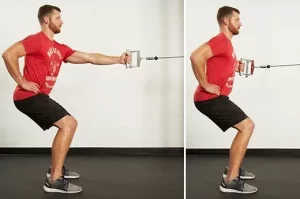
TRX Pull-Up
- Adjust the TRX handles so that you can perform the upper pull-up phase entirely off the ground.
- Sit fully on the ground with your legs outstretched, and grasp both handles.
- You should be standing tall and straight up at the start of the TRX pull-up, with your entire body off the ground.
- Drive your elbows towards the floor and raise yourself until your hands are in line with your chin to start the exercise.
- Returning to the beginning position requires slowly extending the shoulders and elbows.
- Then relax.
- Do five to ten repetitions of this workout each day.
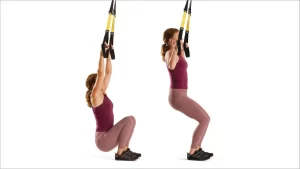
Under the Bar Pull Ups
- When holding the bar upright with your arms fully extended, adjust the height of the bar such that your body appears suspended.
- Keep your shoulders back and down and your chest large during this exercise.
- Raise your torso until your chin is parallel to the bar, or higher.
- In order to finish the exercise, lower your body back to the beginning position.
- Then relax.
- Do five to ten repetitions of this workout each day.
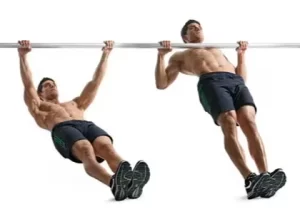
Lat Pulldown
- To stay in place, set up the leg locks on a lat pulldown machine.
- As you reach for the bar, make sure your thumbs are supporting it and that it is positioned low in your palms.
- Ensure that your grip is somewhat wider than shoulder breadth.
- Keep your back arched and your chest large while maintaining a great, erect stance.
- Lower the bar with your hands until it is parallel to your chin.
- To finish the repetition, control the bar back to the beginning position.
- Then relax.
- Do five to ten repetitions of this workout each day.
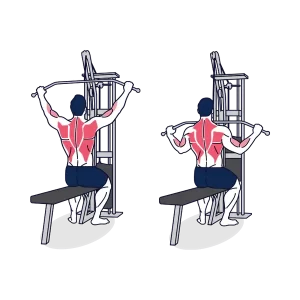
Pull-Ups
- You can increase the difficulty of a pull-up by using a broader grasp on the pull-up bar or decrease it by using a narrower grip.
- Keep your back arched and your chest large while maintaining a great, erect stance.
- Pull your body up with your hands so that the bar is below your chin.
- To finish the repeat, control your body back into the starting position.
- Then relax.
- Do five to ten repetitions of this workout each day.
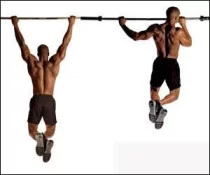
Kroc Rows
- Kroc rows, in contrast to dumbbell rows, are often done with both feet on the ground and one hand placed on a bench or weight rack to support your weight (assuming the gym is not too busy).
- Reposition the rowing arm’s leg.
- Keep your back straight. Still, there will be some motion.
- This is crucial: let the dumbbell drop until it pushes your shoulder down and your scapula forward.
- Pull the dumbbell up alongside the body and the scapula pack with a powerful motion.
- Concerning “squeezing” at the top, do not worry.
- Allow the dumbbell to descend one more, then repeat.
- Then relax.
- Do five to ten repetitions of this workout each day.
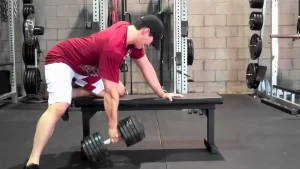
Renegade Row
- Establish a push-up position while holding two hex dumbbells in each hand.
- Hands should be parallel to and slightly wider than your shoulders.
- This is your starting point.
- Lift the dumbbell with your right hand to the side of your torso while keeping your core engaged, elbows tucked, and body straight from head to heels.
- Make a 90-degree bend in your elbow so you’re rowing to your ribs rather than your armpits.
- After a little delay, go back to where you were before.
- Row the dumbbell using your left hand this time.
- Continue to alternate sides.
- Then, relax.
- Perform 5 to 10 repetitions of this workout every day.
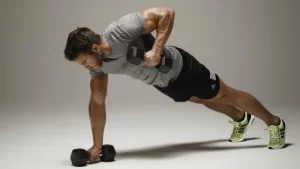
Curl Gottman
- Keeping a dumbbell at arm’s length by your sides, palms facing front (underhand grip), stand tall.
- Your elbows should be tucked and locked by your sides.
- Curl the weights up and over your shoulders.
- Turn the dumbbells 180 degrees so that your hands are facing down.
- Lower the weights to your sides and then switch your grip (to underhand).
- Return to your starting point.
- Then, relax.
- Perform 5 to 10 repetitions of this workout every day.
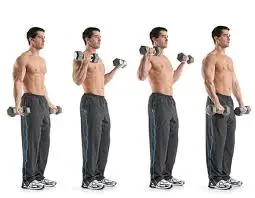
Triceps press down
- Turn to face the cable machine or the location where you have the resistance band tied while standing upright with your knees slightly bent.
- Hold the resistance band or cable at its peak.
- Pull the cable or band down towards the ground while keeping your elbows by your sides.
- Pull the cord until your arms are completely extended.
- Return to your previous location.
- Then, relax.
- Perform 5 to 10 repetitions of this workout every day.
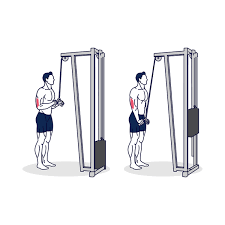
Pullovers
- Begin by reclining on a bench, knees bent, and feet flat on the floor.
- Hold the dumbbell with your palms facing out and your hands shoulder-width apart.
- Increase your arms directly over your head and raise the load over your head.
- Bend your elbows and lower the weights behind you until they are totally behind you.
- Return the weight to your shoulders and repeat for the desired number of repetitions.
- Return to your previous location.
- Then, relax.
- Perform 5 to 10 repetitions of this workout every day.
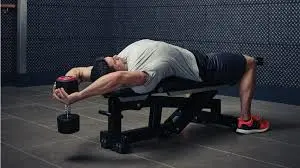
Barbell biceps curls
- Begin by placing your feet hip-width apart.
- Grip a barbell in each hand, palms facing your thighs.
- Lift the barbell towards your shoulders with your elbows tucked into your sides.
- Return the weights to their starting position.
- Then, relax.
- Perform 5 to 10 repetitions of this workout every day.
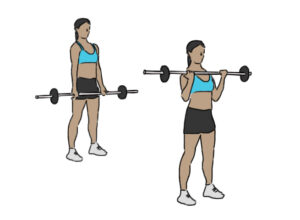
Cable Curls
- Begin by placing your feet hip-width apart.
- Grip the cable with your hands shoulder-width apart and your palms facing away from you.
- Curl the wire up to your shoulders while keeping your elbows close to your sides.
- Return the cable to its original location.
- Then, relax.
- Perform 5 to 10 repetitions of this workout every day.
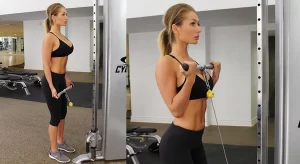
Deadlifts
- Lay a barbell with the weight you want on the ground.
- Place your toes under the bar and place your feet hip-width apart.
- Just outside of your knees, place your hands on the barbell.
- Double overhand grips and overhand-underhand grips (alternating grips) are also options.
- Maintain a straight back and an erect chest while bending at the hips and knees.
- The handle should be close to the area of your shins.
- Engage your glutes and hamstrings as you push into your heels.
- Straightening your hips and knees at the same time will help you lift the barbell.
- After you’re upright, take a moment to check that your spine is neutral.
- By pushing your hips back and carefully lowering the barbell, you can reverse the exercise.
- Perform 5 to 10 repetitions of this workout every day.
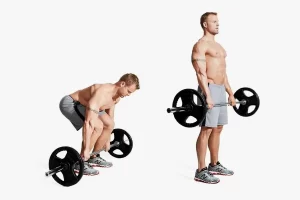
Dumbbell Preacher Curls
- Commence by placing your feet flat on the floor while sitting on a preacher curl bench.
- With the palms of your hands towards your thighs, hold a dumbbell in each hand.
- Curl the weights up to your shoulders while placing your arms on the pad in front of you.
- After the required number of repetitions, return the weights to their starting position.
- Then, relax.
- Perform 5 to 10 repetitions of this workout every day.
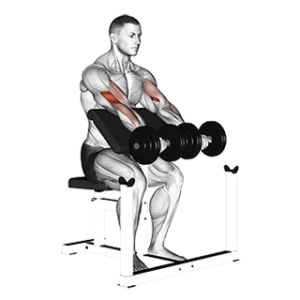
Pull-Apart of Resistance Bands
- As you stand, spread your toes shoulder-width away.
- With your elbows slightly bent and your palms facing the floor, stretch your arms straight in front of your body in line with your shoulders while holding a taut resistance band between both hands.
- Pull fists out past your shoulders while tensing your core and squeezing your shoulder blades together.
- Return gradually to the beginning.
- Then, relax.
- Perform 5 to 10 repetitions of this workout every day.
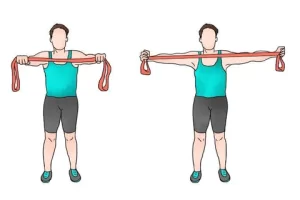
Adopt Following Safety Measures When Exercising:
- If an activity causes you discomfort, don’t do it.
- Spend some time working out.
- There’s no hurry in this.
- You must utilize the appropriate tools.
- Wear comfortable shoes and loose-fitting attire.
- Make sure you warm up appropriately before working out.
- Give up exercising if it is seriously hurting you.
- If you experience any pain or discomfort throughout your workout, you should immediately stop.
When did the patient stop taking part in the exercise?
- If a patient suffers back pain, weightlifting exercises should be avoided.
- If the patient experiences any aches or pains when performing this exercise.
- If a person’s muscles hurt, they shouldn’t exercise.
- If a person is sleep-deprived, they may decide not to work out.
- You spread quickly.
- If there’s any discomfort or numbness.
- Elevated temperature
- Headache
- Exercise should be stopped if it hurts.
In conclusion:
“Pull” exercises strengthen the forearms, biceps, and back. Training sessions focused on muscle groups that execute comparable movements are sometimes called pull training splits. Regardless of training experience level, everyone can undertake the pull training regimen, which promotes muscle repair. A well-thought-out pull day is essential to your overall training program. Every exercise you’ve done focuses on particular muscle groups to promote balanced upper body growth that goes beyond appearances. Pull-ups, rows shrugs, and other exercises work well together to build a solid base of strength and utility. Pull and other multi-joint exercises use more muscles and strain the cardiovascular system, improving strength and cardiovascular fitness.
Pull-day workouts are great because they are flexible. Your pull-day regimen can change as you do. It can grow and change with you. You should feel free to tailor your workouts to your own needs, preferences, and your body’s particular reaction. You can customize your practice to achieve your goals of hypertrophy, functional strength, or better posture thanks to its adaptability. Pull exercises can be done with a variety of equipment, but bodyweight workouts like chin-ups and pull-ups can also be a good substitute.
The following are a few of the top upper-body pulling exercises;
- Bent over row
- Pull up
- Bicep curl
- Hammer curl
- Lat pull-down
- Rear delt fly
- Renegade row
Some of the greatest pull exercises for strengthening and conditioning upper body muscles were these. Try to include them in your pull-day exercise routine and observe how well they can aid in the development of your upper body strength. Try to do 10 reps at first when performing these exercises. Exercises involving pulling motions can assist in building strength, which can lead to better mobility in everyday activities as well as more demanding ones.
FAQ
What is a pull-your-upper-body exercise?
Exercises that involve pulling are frequently performed on the face, biceps, rows, and pull-ups. The latissimus dorsi (lats), rhomboids, traps, rear deltoids, and biceps are among the muscles worked during these exercises.
Which are some effective pull workouts?
Rows with dumbbells
Lat Pulldowns
Barbell Rows
Face pull
Which muscles in the upper body pull?
The “push” exercise works the triceps, shoulders, and chest as well as other pushing muscles in the upper body. The back and biceps, as well as all other upper body pulling muscles, are trained during the “pull” workout.
Are the five upper body exercises sufficient?
Five or more, though, might be perfectly fine for you, depending on what you’re doing and your energy level for the day. Just make sure you’re training each muscle group twice a week by doing two exercises for each muscle group and enough sets per week.
Is pulling less powerful than pushing?
According to a meta-analysis of the literature on pushing and pulling, humans can safely exert more force when pushing than when pulling. This is because of the pushing-related postures and muscle recruitment. It depends on the circumstances, though.
Was daily upper body exercise okay?
Lifting weights daily is not necessary, and if you do, you run the risk of overtraining syndrome and overuse injuries. Strength training should be done two to three times a week for most people, but you can train up to five days a week if you would rather split your time between different muscle groups.
Which upper body exercise is the simplest?
Newbie Upper Body Exercise,
Push-ups on the chest.
Fly on the chest.
Pulls the lats.
Bent arm lateral raises.
Overhead presses.
How many pull exercises are recommended?
The number of movements necessary to work the upper and lower bodies to a respectable degree. Recall that the quality of your workouts matters more than the quantity, so focus on working out all of your major body parts.
How frequently are you likely to go to the fitness center?
On the day you are directly training a muscle group, it is customary to perform two to four exercises for that muscle group. Accordingly, depending on how frequently you train each week, you could perform 4–16 distinct exercises for each muscle group in a given program (the more workouts per week, the more different exercises you can add).
What kind of exercise is pull?
Exercises like pull-ups are just one kind of exercise you can do to build and strengthen your body. These exercises involve pulling your body toward a sturdy external object or applying an external weight to yourself, as their name suggests.
When are able to you quickly develop the upper body?
By performing compound upper body exercises like push-ups, bench presses, back rows, and assisted pull-ups, beginners in the gym can develop their upper body strength. Try to use weights that are challenging for you twice a week to work your upper body. Strengthening oneself by performing lower reps with heavier weights is a common recommendation.
Which pull-up exercise is the hardest?
The hardest pull-up to perform is the overhand grip pull-up since it puts more strain on your lats. A wider grip results in less support from other muscles for your lats, which makes a rep harder.
Why are pull-out exercises effective?
Pulling-based upper-body exercises make up the standard pull-day workout regimen. They work the muscles in the back, forearms, and biceps mainly.
Pull movement: what is it?
Bringing an object closer to you, like pulling rope lines, or drawing yourself closer to an object, like a pull-up, indicates the pulling movement.
Can I use dumbbells for pull exercises?
Workout Routine for Home Pull Days Using Only Dumbbells,
Single-Arm Rows
Renegade Rows
Shrugs
Deadlifts
Dumbbell Pullovers
Reference
- March 13, Van De Walle Ms Rd, G. 2023. Push-Pull Workout Schedules and Muscle Building Guide. The website Healthline provides information on exercises for push-pull workouts. Reference within the text: Van De Walle MS Road, 2023
- A. Z. Cscs, September 11, 2023. The Top 8 Exercises for Upper Body Pulling. fracturing muscle. The best upper-body pulling exercises can be found at https://breakingmuscle.com. Reference inside text: (Cscs, 2023)
- J. Bakhshinejad. September 24, 2022. Best Upper Body Pull Exercises (Plus a Workout Sample) – PowerliftingTechnique.com. PowerliftingTechnique.com. https://powerliftingtechnique.com/upper-body-pull-exercises/. Reference: (Bakhshinejad, 2022)
- D. Luna, August 28, 2023. The Top 10 Upper Body Pull Exercises (With Pictures!). Motivate us. https://www.inspireusafoundation.org/upper-body-pull-exercises/. Citation: (Luna, 2023)
- The Top 12 Pulling Exercises to Increase Muscle and Strength, Set, S. F., n.d. SET IN FOR SET. The top twelve pulling exercises for the upper and lower body can be found at https://www.setforset.com/blogs/news. Reference within the text: Set, n.d.
- Breitowich, A. September 8, 2022. Trainers’ Favourite Pull Exercises for Your Upper And Lower Body Are Included in This Pull-Day Workout. The Health of Women. Pull-day training plan: https://www.womenshealthmag.com/fitness/a40951268/ In-text Citation: (Breitowich, 2022)
- Pull Day Exercise Programme for Increasing Muscle Mass | “A Day-to-Day Exercise Programme for Gaining Muscle Mass | LADDER,” n.d.|
- Best Pull Day Workout Routine Plus 11 Most Effective Exercises. November 10, 2023. Huge Supplements. Huge Supplements, https://blogs.com/content/best-pull-day-workout. In-text citation: “11 Most Effective Exercises + The Best Pull Day Workout Routine,” 2023)
- Z, T. September 10, 2023. The Greatest Pull Day Routine & 12 Activities to Complete in Your Split. American branch of TRX Training. Pull-day workout: https://www.trxtraining.com/blogs/news. In-text citation: (Z, 2023)
- Image 2, Neudecker, K. January 30, 2023. For larger, wider shoulders, master the dumbbell shrug. Male Health. [https://www.menshealth.com/uk/fitness/a753510/dumbbell-shrug/] Neudecker (2023) is the in-text citation.
- Image 5, J. (June 6, 2018). Build A Broader, V-Tapper Back With The Meadows Row Workout. GymGuider.com. This is a Meadows Row Workout that builds a larger V-taper back. Reference in Text: (2018)
- Image 7, K. A. F. CSCS (2023, March 4). How to Perform a Dumbbell Row with Your Chest Supported for a Stronger Back and Biceps. BODi. Chest-supported row dumbbell incline: https://www.beachbodyondemand.com/blog Reference inside text: (CSCS, 2023)
- Image 9, Warren, M. April 6, 2021. The Banded Pullover is a Hint. TIP THE BANDED PULLOVER, T NATION. https://www.t-nation.com/training/Reference in Text: Warren, 2021
- Image 10, Pull-Up Resistance Bands: How to Use Them for Pull-Ups – Atemi Sports, April 28, 2023. The following is an in-text citation for Atemi Sports’ Resistance Bands for Pull-Ups | How to Use Pull-Up Assist Bands: https://atemi-sports.com/resistance-bands-for-pull-ups/ – 2023 Atemi Sports
- Image 11, 2021, October 24.FW 1005 – TBar Row – Into Wellbeing. Into Well-Being. Tbar-row-FW-1005/ https://www.intowellness.in/product/strength/fw-seriesText Citation: (Into Wellness, 2021 – TBar Row – FW 1005)
- Image 13, B. Hughes (2018) 10 July. Standing Single Arm Cable Row is a good exercise tip. https://premiersportsplex.com/2018/07/10/trainer-tip-standing-single-arm-cable-row/ Premier Sportsplex. In-Reference in Text: Hughes, 2018
- Image 14, TRX Pull-Up Technique. (2023, August 16). Live life to the fullest. In-depth: https://experiencelife.lifetime.life/article/break-it-down-the-trx-pull-up/Text Reference: (How to Do the TRX Pull-Up, 2023)
- Image 15, Mock, R. (December 24, 2020). Australian Pull-ups: In-Depth Analysis. Australian pull-ups: a detailed investigation, Kensui, https://kensuifitness.com/blogs/news Reference inside text: (Mock, 2020)
- Image 18, J. A. (20 August 2011). Kroc rows 150 pounds for 20 seconds. YouTube. https://www.youtube.com/watch?v=9E8NuWzb-oQ (2011) in-text citation
- Image 20, K. (9 August 2015). Bodybuilding Wizard’s Standing Zottman Curl Technique. https://bodybuilding-wizard.com/standing-zottman-curl/standing-zottman-curl-exercise-guide-1-2/ In-Text Citation:
- Image 23, Barbell biceps curl – GoFitnessPlan. GoFitnessPlan.com. https://www.gofitnessplan.com/exercises/barbell-biceps-curl/ (Go Fitness Plan, n.d.) In-Text Citation: (Barbell Biceps Curl – GoFitnessPlan, n.d.)
- Image 24, P. (September 14, 2021). Straight Bar Cable Curl Exercise – Be Your Best. The Optimal You | Holistic Nutrition & Online Personal Trainers. In-depth: https://the-optimal-you.com/cable-curl-with-bar/(2021) Text Citation
- Image 25, Romanian Deadlift | Method & Advantages of This Unstoppable Workout Manual | DMoose (n.d.). Italian deadlift by DMoose. https://www.dmoose.com/blogs/hamstrings In-text Citation: (Romanian Deadlift | Method & Advantages of This Unstoppable Workout Manual | DMoose, n.d.)


